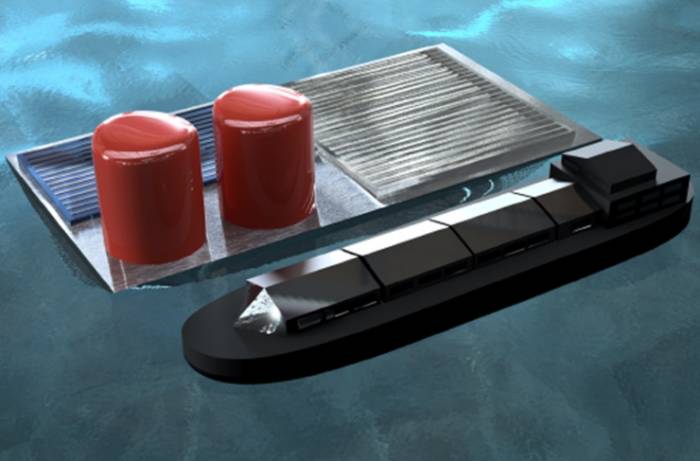
Engineers at Columbia University have developed what they say is practical floating solar powered hydrogen-generating device that doesn’t require pumps or membranes.
It’s envisioned the “solar fuels rig” concept could eventually be deployed on the ocean to produce hydrogen fuel in large quantities from sunlight and water.
Solar panels positioned on top of the rig would convert light into electricity used to power the electrolyzer submerged below, where the magic happens.
Instead of using expensive membranes to keep hydrogen and oxygen gas created during the electrolysis process separate, membranes that can be destroyed by impurities in seawater, the device uses an electrode configuration enabling gases to stay separated.
The mesh electrodes used in the Columbia researchers’ device are coated with a catalyst on one side only, constraining the generation of hydrogen and oxygen gas to these areas to ensure the bubbles don’t mix.
The oxygen vents to the atmosphere while hydrogen is captured in a storage reservoir. In a large-scale operation, the hydrogen could be transferred to a tanker and then shipped to shore.
“The design enables efficient operation with high product purity and without actively pumping the electrolyte. Based on the concept of buoyancy-induced separation, the simple electrolyzer architecture produces H2 with purity as high as 99 percent,” states an article posted on the Columbia University web site.
The Columbia team has already developed a small working stand-alone PV-electrolyzer prototype that floats in a liquid reservoir of sulfuric acid. The researchers are now refining their design for more efficient operation in real seawater, which poses some additional challenges.
“We are especially excited about the potential of solar fuels technologies because of the tremendous amount of solar energy that is available,” said Daniel Esposito, assistant professor of chemical engineering at Columbia Engineering,
Research into the use of solar energy in generating hydrogen is occurring throughout the world. Closer to home, solar powered technology being developed CSIRO could see Australia becoming a major exporter of hydrogen in ammonia form.
The potential for hydrogen is certainly very interesting, but it raises the question – if a shift to hydrogen fuels occurs in earnest, what would be the impact of large quantities of additional water vapour, a product of burning hydrogen, in our atmosphere?
It wasn’t that long ago that many believed (and some still do) that carbon dioxide created through the burning of fossil fuels couldn’t possibly alter the world’s climate.
However, it doesn’t have to be an either/or situation, a case of picking a single winner – a wide range of clean and renewables-based technologies will likely (hopefully?) power our energy future.

 RSS - Posts
RSS - Posts



Hi Michael,
Thanks for this interesting blog, interesting just this morning I was researching (or as my spouse puts it “wasting time of the internet), looking at fuel cell cars. Toyota have a model on sale in the US. The problem seems to be producing, storing and transporting the hydrogen all of which is energy intensive. So the Columbia University engineers solution is interesting.
Atmospheric water vapor is a green house gas, however it has a very short residency period. That is, it leaves the atmosphere, usually in the form of rain within a matter of days. When this gas or vapor turns back into a liquid it also releases its heat, so the effect on global warming is short term and temporary. The physics and chemistry are well establish and indeed it is taught at school as the water cycle.
This compares with CO2 which has a residency of 40 to 100 years, which is why adding to atmospheric concentrations of CO2 is such a problem, humans are adding it to the atmosphere much more quickly than natural carbon sink processes can absorb it.
Cheers